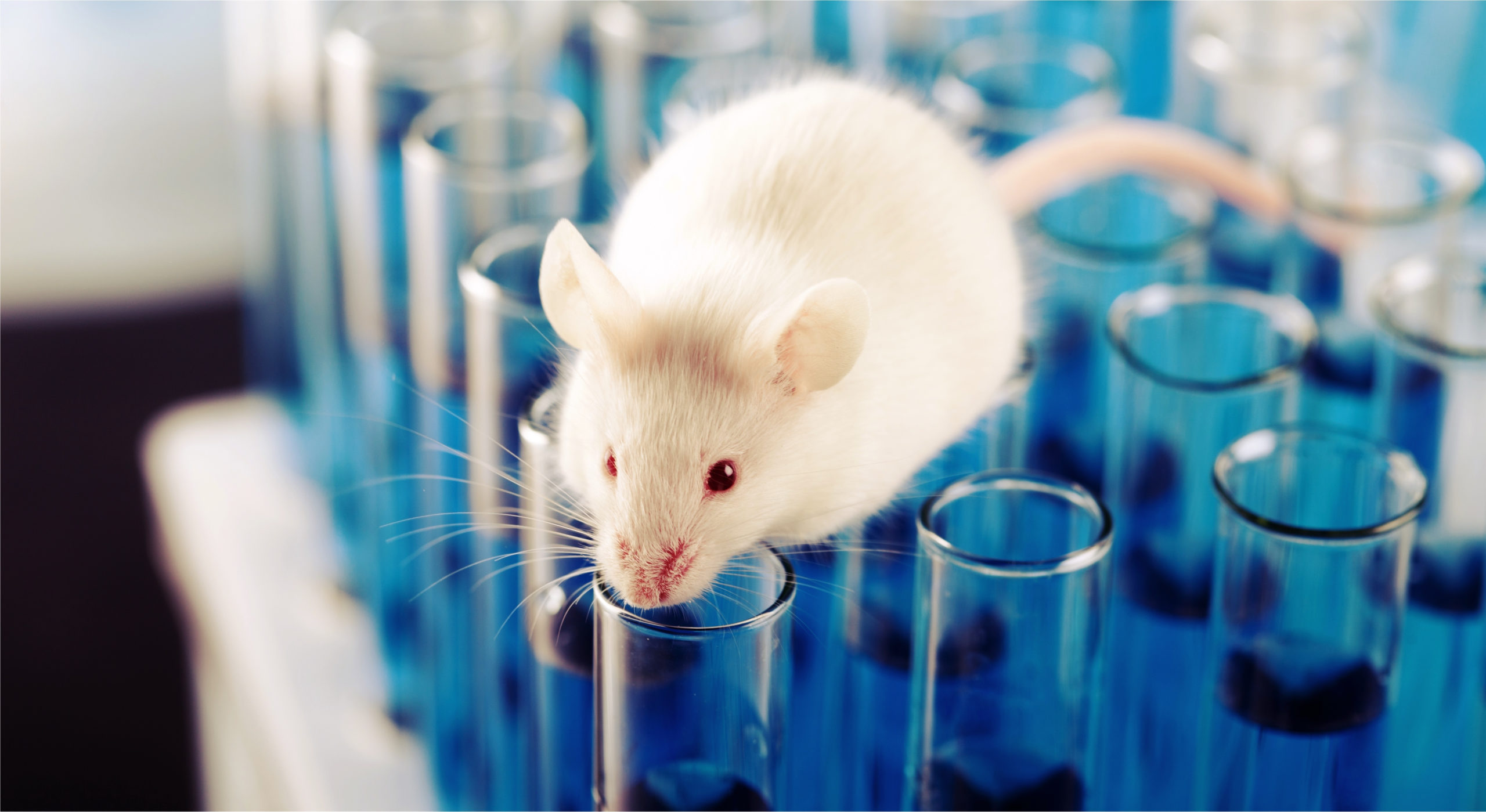Bridging The Gap

What is an animal model?
July 15, 2020
As scientists rapidly investigate how SARS-CoV-2 causes disease and attempt to develop therapies and vaccines, there is one piece of technology that is vital to the research – the animal model of a disease.
While clinical trials of a treatment are used to determine many aspects of safety and efficacy, before the drug is tested in humans, quite a bit of preclinical work is needed. This is where animal models come in.
Animal models are complex – they are complex to develop, they are extremely varied, and there are thousands of known animal models of diseases. The topic can’t be fully addressed in one blog! We’ll try to delve into an introduction here.
So you’ve identified a compound that you think can help treat a disease. You’ve identified a target that’s involved in a disease, found or built a molecule that inhibits or activates that target, and undergone lead optimization of your molecule – resulting in a compound that you ultimately want to take into clinical trials.
Now you need to start answering questions about your compound. These could include whether the compound actually hits the desired disease target, if the compound is selective enough to hit the target without hitting others, and if the compound is potent enough to produce an effect.
Clinicians who ultimately test these compounds in humans want to know what drug level is needed and for how long? What dosing interval do you need to maintain the level of activity to impact your target?
SPARK advisor Dr. Dirk Mendel said “These questions are generally addressed using various models, namely biochemical, cellular, and animal models.”
The type of model chosen will depend on the questions posed. As SPARK advisor Dr. Steve Schow added, “depending on the specific biomedical question being addressed, different animal species can serve as the model of choice.”
So what, exactly, is an animal model of a disease?
An animal model is a non-human species used in medical research because it can mimic a disease found in humans. It’s a tool that researchers use to study diseases and test treatments in cases where human experimentation is not possible or unethical, says Dr. YJ Tan, who just completed his Ph.D. in epidemiology and clinical research at Stanford School of Medicine.
Why do we test drugs and therapies in animal models, and why are they so important for drug development?
There are ethical guidelines governing human experimentation, meant to minimize harm to a person’s physical or mental health. Clinical trials must be approved by an ethics committee before proceeding with experimentation of a drug on humans. Clinicians need to have some sense of the safety and efficacy of a drug before unleashing an experimental compound on humans.
Instead, a researcher could test a drug directly on human cells, but cells in a dish won’t tell you how a drug acts inside a body, or even more importantly, how the body responds to the drug. “Human physiology is much more complex and nuanced than the simple summation of cellular or even isolated tissue effects,” Schow said.
An animal model is the best approximation of a human body without actually using a human. Animals comprise multiple cell types, organs, circulatory systems, and other systems that cells alone, even when layered, don’t.
“In cell culture, you don’t have a representative picture of what will happen when the drug is put into an organism. In an organism, the drug has to interact with 3D organs, multiple cell types, and be distributed from the site of administration to the target organ,” said Tan.
Animal models are mainly used to determine if a drug is safe. A researcher can also test different doses of a product and test its nature, chemistry and effects in the body, such as how much drug is absorbed into the blood, how long it lasts in the body, and how it is broken down chemically. Animal models also allow for testing of the toxicity of a product and its breakdown components (metabolites). Before beginning a clinical trial, animal models help determine a dose and schedule that will be used on human subjects. When submitting an Investigational New Drug application to FDA – the regulatory step to get approval to conduct studies in humans – researchers need to conduct toxicology tests (to study adverse effects) in two different animal models.
Mendel said, “IND-enabling studies are carefully designed to get a complete assessment of the safety and potential risks of the new compound, and to identify a safe starting dose at which to initiate clinical studies.”
U.S. federal law requires that all research at an institution performed on laboratory animals is carefully reviewed by an oversight committee prior to testing to ensure ethical treatment of the animals. “We do animal studies very carefully, both trying to treat the animals as humanely as possible and only allowing studies that have scientific merit,” said SPARK co-director Dr. Kevin Grimes.
There are multiple types of animal models using mice, ferrets, hamsters, monkeys, even dogs and cats. Even flies and worms serve as models of disease! The most popular animal model is the rodent, or more specifically, the laboratory mouse. Mice are small and readily available, are easy to handle and breed quickly, and are less expensive than larger animals like monkeys or dogs. The animal that most closely resembles a human is the non-human primate and so carries the most weight in preclinical research. However, primates are expensive, limited, and difficult to handle, so a researcher must carefully consider whether their question must be answered in a primate model, or if another animal is sufficient.
Animal models may arise spontaneously, in which the animal naturally contracts that disease. Others may be experimental, in which the disease is induced in the animal. This typically involves breeding or genetically engineering animals to have a particular phenotype. Some models may have limitations – “maybe another model has different aspects of your disease,” Mendel said.
Animals with transplanted human cancers or other tissues are called xenograft models.
New diseases such as COVID-19, however, do not have developed animal models. In this case, an animal model of the disease must be created, and in the case of a quickly spreading pandemic, must be developed rapidly.
How are animal models developed for a novel disease like COVID-19?
A researcher may start by trying to infect animals with a virus like SARS-CoV-2 and observing the results – does the animal exhibit the same symptoms and responses to the virus as humans? If that doesn’t work, an animal may be manipulated to recreate the human condition.
Researchers are facing unique challenges in developing animal models of COVID-19 during the current pandemic. Stay at home orders isolate researchers and make it challenging to access resources and labs. COVID-19 models need to be developed and experiments must be performed in biosafety level 3 labs, which are few and far between, Tan said.
Schow said, “As with any new disease, rapidly identifying a predictive animal model helps enable new therapeutic discovery. However viral infection animal models can be tricky because the virus might not take up residence in the typical laboratory animal model species.”
“The disease caused by COVID-19 infection is very complex, still pretty poorly understood, and seemingly potentially very different in different people,” Mendel said. However, enough is known about the disease to understand that “a good animal model in which to study COVID-19 therapeutics would ideally mimic the viral replication in the lung and the immune response resulting from the infection,” he added.
Tan said challenges of creating a COVID-19 model include making sure there is a readout for the effect of disease (i.e., is the virus lethal in the model?) and ensuring the disease in the model is similar to that in humans, such as development of pneumonia.
Researchers are working quickly to develop COVID-19 models in different species. One promising model is the Syrian hamster, which appears to mimic the clinical, virological and immunological aspects of human disease. Infected hamsters also readily transmit the virus to uninfected animals, which can help researchers understand how the virus spreads in humans.
Since the mouse and rat ACE2 receptors – which SARS-CoV-2 uses to enter cells – differ from the human ACE2 receptor, particularly in the region of the receptor that interacts with the viral spike protein, the virus cannot effectively infect mice or rats, making them poor animal models of COVID-19. However, groups are developing transgenic mouse models with human ACE2 that appear to recapitulate COVID-19 pathogenicity.
“Non-human primates (NHP), on the other hand, seem to be a very good model of humans,” Mendel said. The SARS-CoV-2 virus infects NHPs and they develop symptoms similar to those in humans, so they could be good models to test therapeutics, Mendel added.
A recent study showed that monkeys may have a milder form of infection than humans, although the lung pathology in the monkeys could be informative for human disease.
Ferrets, cats and rats are also showing promise as COVID-19 models.
For further reading, there are a few handbooks dedicated to animal models, including Animal Models for the Study of Human Disease and Handbook of Animal Models of Infection.
